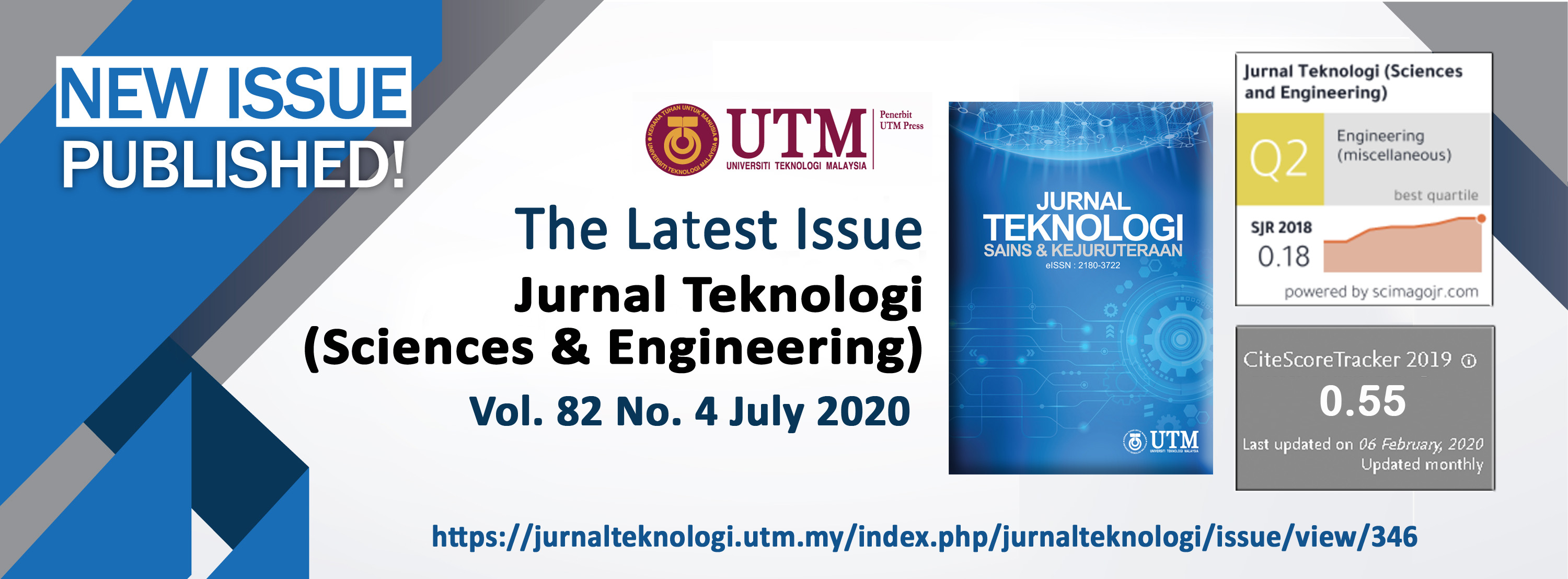UTILIZATION OF TEA WASTE AS AN ALTERNATIVE FILLER FOR NATURAL RUBBER
DOI:
https://doi.org/10.11113/jt.v82.14400Keywords:
Natural rubber, Tea waste, Filler, Tensile properties, MorphologyAbstract
Tea leave is considered worthless after being discarded. It frequently dumps to the environment without providing the best solution on it. In this study, tea leave waste (TW) was applied to be used as alternative filler for natural rubber. The study was evaluated through the curing characteristics, tensile properties and the morphology of the composites. The results have shown some interesting findings. As for the curing characteristics, the maximum torque was increased with increasing the TW loadings whereas the scorch and curing time showed the decreasing trend. The tensile modulus was also influenced by the addition of TW which correlated to the maximum torque observed. The extent of mechanical properties depends on the loadings of TW. Considering the amounts of TW, a 10 phr of TW was found to be a content of choice for natural rubber. It provided a balance set of properties regardless whether the mechanical properties and morphological characteristics of the natural rubber.
References
Sae-Oui, P., Sirisinha, C. and Thaptong, P. 2009. Utilization of Limestone Dust Waste as Filler in Natural Rubber. Journal of Material Cycles and Waste Management. 11: 166-171. DOI: 10.1007/s10163-008-0230-4.
Ismail, H., Rozman, H., Jaffri, R. and Ishak, Z. M. 1997. Oil Palm Wood Flour Reinforced Epoxidized Natural Rubber Composites: The Effect of Filler Content and Size. European Polymer Journal. 33: 1627-1632. DOI: 10.1016/S0014-3057(97)00020-7.
Ismail, H. and Haw, F. 2008. Effects of Palm Ash Loading and Maleated Natural Rubber as a Coupling Agent on the Properties of Palmâ€ashâ€filled Natural Rubber Composites. Journal of Applied Polymer Science. 110: 2867-2876. DOI: 10.1002/app.28844.
Imanah, J. and Okieimen, F. 2003. Rheological and Mechanical Properties of Natural Rubber Reinforced with Agricultural Byproduct. Journal of Applied Polymer Science. 90: 3718-3722. DOI: 10.1002/app.13058.
Ismail, H., Osman, H. and Jaafar, M. 2008. Hybridâ€filler Filled Polypropylene/(natural rubber) Composites: Effects of Natural Weathering on Mechanical and Thermal Properties and Morphology. Journal of Vinyl and Additive Technology. 14: 142-151. DOI: 10.1002/vnl.20156.
Fiorote, J. A., Freire, A. P., de Sousa Rodrigues, D., Martins, M. A., Andreani, L. and Valadares, L. F. 2019. Preparation of Composites from Natural Rubber and Oil Palm Empty Fruit Bunch Cellulose: Effect of Cellulose Morphology on Properties. BioResources. 14: 3168-3181. DOI: 10.15376/biores.14.2.3168-3181.
Roy, K. and Potiyaraj, P. 2018. Development of High Performance Microcrystalline Cellulose based Natural Rubber Composites Using Maleated Natural Rubber as Compatibilizer. Cellulose. 25: 1077-1087. DOI: 10.1007/s10570-017-1613-2.
Uddin, M. T., Islam, M. A., Mahmud, S. and Rukanuzzaman, M. 2009. Adsorptive Removal of Methylene Blue by Tea Waste. Journal of Hazardous Materials. 164: 53-60. DOI: 10.1016/j.jhazmat.2008.07.131.
Song, X., Ma, X., Li, Y., Ding, L. and Jiang, R. 2019. Tea Waste Derived Microporous Active Carbon with Enhanced Double-layer Supercapacitor Behaviors. Applied Surface Science. 487: 189-197. DOI: 10.1016/j.apsusc.2019.04.277.
Utomo, H. D. and Hunter, K. 2006. Adsorption of Divalent Copper, Zinc, Cadmium and Lead Ions from Aqueous Solution by Waste Tea and Coffee Adsorbents. Environmental Technology. 27: 25-32. DOI: 0.1080/09593332708618619.
Bernal, M. P., Sommer, S. G., Chadwick, D., Qing, C., Guoxue, L. and Michel, F. C. 2017. Chapter Three - Current Approaches and Future Trends in Compost Quality Criteria for Agronomic, Environmental, and Human Health Benefits. In: D.L.B.T.-A. in A. Sparks (Ed.). Academic Press. 143-233.
Lorenz, O. and Parks, C. R. 1961. The Crosslinking Efficiency of Some Vulcanizing Agents in Natural Rubber. Journal of Polymer Science. 50: 299-312. DOI: 10.1002/pol.1961.1205015404.
Tian, L., Shen, B., Xu, H., Li, F., Wang, Y. and Singh, S. 2016. Thermal Behavior of Waste Tea Pyrolysis by TG-FTIR Analysis. Energy. 103: 533-542. DOI: 10.1016/j.energy.2016.03.022.
Hayeemasae, N., Ismail, H. and Azura, A. R. 2013. Blending of Natural Rubber/Recycled Ethylene-Propylene-Diene Monomer: Cure Behaviors and Mechanical Properties. Polymer-Plastics Technology and Engineering. 52: 501-509. DOI: 10.1080/03602559.2012.762020.
Surya, I., Ismail, H. and Azura, A. R. 2013. Alkanolamide as an Accelerator, Filler-dispersant and a Plasticizer in Silica-filled Natural Rubber Compounds. Polymer Testing. 32: 1313-1321. DOI: 10.1016/j.polymertesting.2013.07.015.
Coran, A. Y. 2003. Chemistry of the Vulcanization and Protection of Elastomers: A Review of the Achievements. Journal of Applied Polymer Science. 87: 24-30. DOI: 10.1002/app.11659.
Xie, Y., Hill, C. A. S., Xiao, Z., Militz, H. and Mai, C. 2010. Silane Coupling Agents Used for Natural Fiber/Polymer Composites: A Review. Composites Part A: Applied Science and Manufacturing. 41: 806-819. DOI: 10.1016/j.compositesa.2010.03.005.
Ismail, H., Khoon, T.B., Hayeemasae, N. and Husseinsyah, S. 2015. Effect of Oil Palm Ash on the Properties of Polypropylene/Recycled Natural Rubber Gloves/Oil Palm Ash Composites. BioResources. 10: 1495-1505. DOI: 10.15376/biores.10.1.1495-1505.
Medalia, A. I. 1976. Effect of Carbon Black on Dynamic Properties of Rubber Vulcanizates. Rubber Chemistry and Technology. 51: 437-523. DOI: 10.5254/1.3535748.
Wang, M.-J., Wolff, S. and Tan, E.-H. 1993. Filler-elastomer Interactions. Part VIII. The Role of the Distance between Filler Aggregates in the Dynamic Properties of Filled Vulcanizates. Rubber Chemistry and Technology. 66: 178-195. DOI: 10.5254/1.3538305.
Mathialagan, M. and Ismail, H. 2012. Optimization and Effect of 3â€aminopropyltriethoxysilane Content on the Properties of Bentoniteâ€filled Ethylene Propylene Diene Monomer Composites. Polymer Composites. 33: 1993-2000. DOI: 10.1002/pc.22340.
Hayeemasae, N. and Ismail, H. 2019. Reinforcement of Epoxidized Natural Rubber through the Addition of Sepiolite. Polymer Composites. 40: 924-931. DOI: 10.1002/pc.24762.
Downloads
Published
Issue
Section
License
Copyright of articles that appear in Jurnal Teknologi belongs exclusively to Penerbit Universiti Teknologi Malaysia (Penerbit UTM Press). This copyright covers the rights to reproduce the article, including reprints, electronic reproductions, or any other reproductions of similar nature.
















